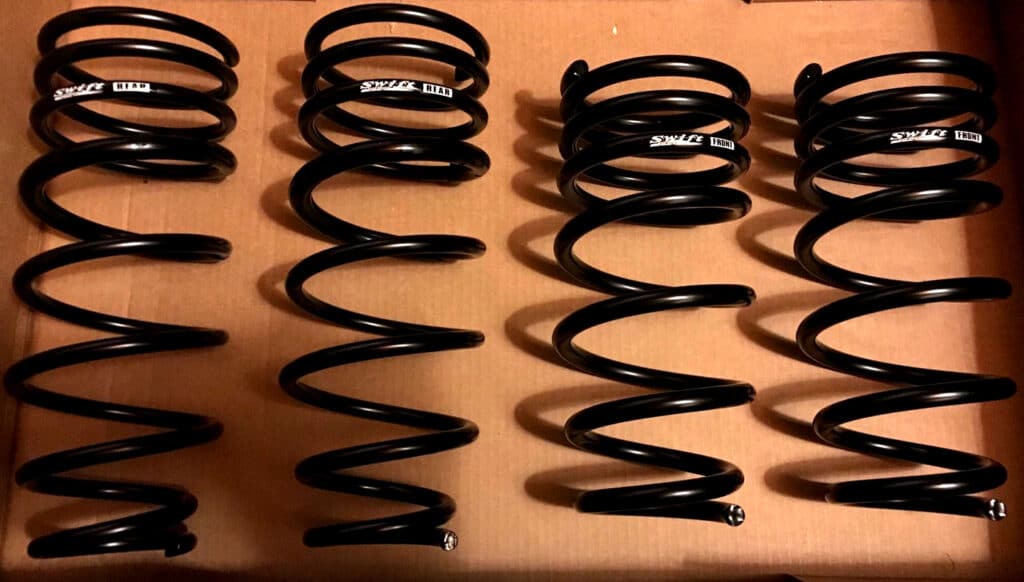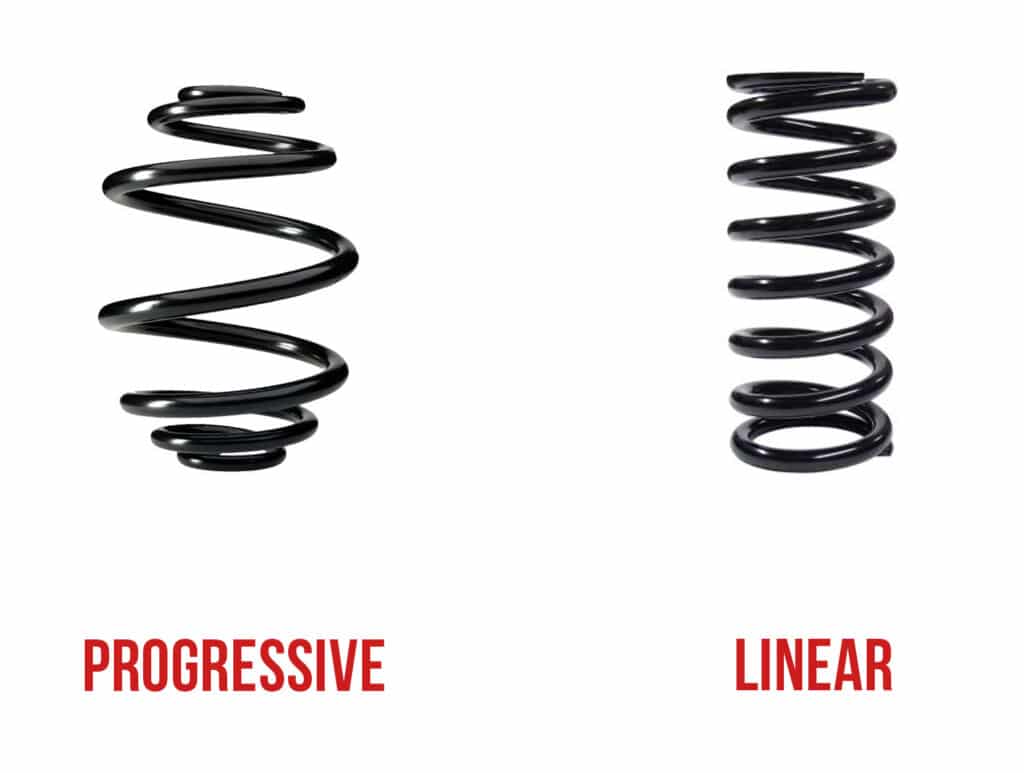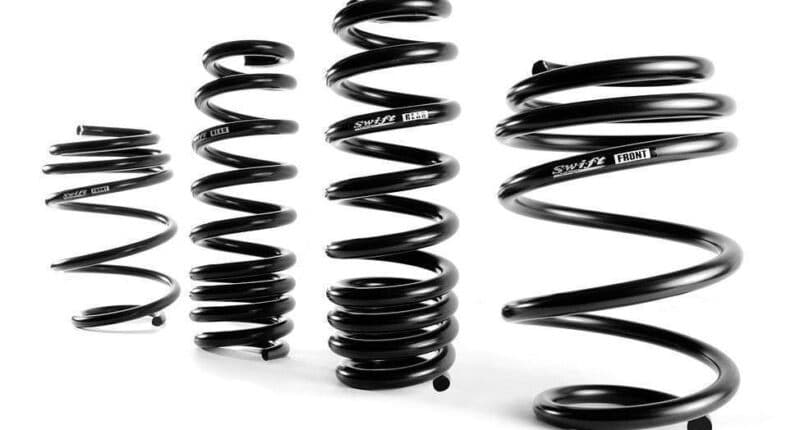The automotive suspension system is a beautifully executed contraption made up of complicated components.
Track day frequenters will know the importance of fine-tuned suspension geometry — in addition to improved handling and overall responsiveness, it also provides consistency and quicker lap times.
But what if these parameters can be improved further with a simple upgrade? Enter Swift Springs.
What you need to understand is, not all springs are created equal. The diameters and spring rates can be similar, but the process of manufacturing them plays a huge role in how they perform. That’s where Swift Springs offer a competitive advantage.
As you may know, suspension systems can be categorized based on their application. For example, the levels of precision a Formula Three racer demands are vastly different from that what a normal streetcar needs.
As for springs, if you’re a serious tracker, stiffer spring rates and minimal body roll are your allies. On the other hand, if you intend to pursue off-roading, heavy-duty shocks with longer spring travel are the ones to have.
But whatever the scenario, the fundamentals remain similar; offer consistent feedback while improving performance and ride quality.
So, how different are Swift Springs from its competition? What’s the point of having them? Is there any advantage? Read on as we answer all these questions and more in this guide.
What Are Swift Springs?
Before we jump into the specifics, let’s go back and take a look at the company’s history.
Swift Springs was founded in 1997 in Japan as the motorsports division of Tokyo Hatsujo Manufacturing, a leading player in the spring-making industry since 1924. The goal was simple, to create the lightest and most durable springs that are cost-effective and exhibit superior characteristics.

Their craftsmanship and dexterity have awarded them a rich history in the world of motor racing. Swift Springs has partnered with several teams in 24hrs of Le Mans, Super GT (JGTC), Nurburgring 24hrs, Formula Three, and many other world-class races.
Swift Springs has been involved in almost all racing disciplines: dirt, road, track, rally, autocross, motorcycles, drift, and more. What sets them apart is their innovative production methods.
They make use of a proprietary steel alloy called HS5.TW. Engineers at the company have found that this material maintains the 4 factors listed below:
- The most consistent spring rate throughout the stroke
- The largest amount of stroke
- The highest durability against loss of spring height
- The lightest in weight
How did they do this? They’ve devised a proprietary winding method, which no other spring maker can duplicate. Pair that to the HS5.TW steel alloy, and you’re looking at a significant difference in weight and durability.
In addition to all these, which are pretty much what every other spring maker claims, Swift offers one more key advantage: faster reaction times. This is important for consistent feedback — something all racers consider very useful, regardless of the format.
You’re probably wondering “what if I install a set of stiffer springs? There are tons of them out there, wouldn’t that make the car more responsive and sporty?”
Spring Stiffness Isn’t the Be-All and End-All
A super stiff suspension isn’t always the answer to better handling. Variables like the car’s weight distribution, aerodynamics, tire size, alignment, and wheel track are all factors that determine how well it will handle.
Adjusting your suspension is a fine line between getting them to soak up those bumps while staying as flat as possible during hard acceleration. In essence, the job of a sports suspension is to reduce the car’s pitch and roll without compromising ride quality.
Now comes compression, rebound, and coilover preload adjustment. The concept behind adjusting your compression and damping is far beyond just a mere click or twist of a nut. It’s not so much as how each setting is altered but how they work together that matters.
You could have the perfect compression and damping setting, but if any of the other variables are off, the car will act weird.
And then there are the springs. You wanna make sure to choose the right one, whether it’s Linear or Progressive.

Each has its set of advantages and disadvantages. Ideally, you’d want a good balance between performance and comfort. That’s where Swift Springs comes into play.
Why Install Swift Springs?
If you’re shopping for a set of these, here are a few things that you need to know about Swift Springs.
For starters, Swift Springs have a different cross-section. They’re barrel-shaped rather than just round, and they require fewer coils per inch for the same rate so, there’s less chance of coil binding — something to keep note of.
Secondly, unsprung weight. Having fewer coils makes the actual spring itself lighter. This helps them to react faster and smoother while reducing the unsprung weight.
Using thinner wire ensures there is a wider gap between the coils. This means, there is more stroke for the spring, it has more travel and does not bottom out as early as thicker springs do.
Also, Swift Springs do not droop over time like other brand springs. Offering impressive amounts of consistency, Swift Springs are within 0.5-1.0% of the rate they were when they come out of the box. Even after a year of racing!
Additionally, professional racers have found Swift Springs to have a lot less harmonic vibration. Having Swift-equipped race cars on a shaker rig shows that vibrations are minimal versus the other brands.
Lastly, let’s talk about build quality. There’s no denying how well-engineered Swift Springs are. There are several testimonials praising the company’s impressive quality control. They’re beautifully made, coated, and machined. Also, they come double boxed to prevent damage via shipping.
Are Swift Springs Worth the Money?
Here’s the thing, not everyone is looking to improve their lap times. Let’s just say that most enthusiasts would sacrifice a few tenths of a second for monetary benefits. It’s not like Swift Springs is a must-have on your car. You can always check out other spring makers if a good deal is what you’re after.

However, the build quality and consistency are something that only high-end springs can offer. Swift is among them and is perhaps even the best.
Depending on who you ask, a set of Swift Springs (front and rear) will set you back anywhere between $350-400. That’s a lot of money for a set of springs that most people wouldn’t even notice.
You could easily spend a little more and spring for a set of coilovers (pun intended). Or you can compare lowering springs and coilovers to see which suits your requirements better.
Here’s our opinion. If your car is a daily driver, Swift Springs are something you can live without. However, if you’re a track day junkie, the advantages on offer are worth the premium.
Lastly, think about resale. If you plan on upgrading or reverting to stock settings, coilovers with Swift Springs generally fetch more value. So that’s worth keeping in mind.
Debunking Some of Swift’s Clever Marketing Claims
Although Swift Springs is a fairly reputed brand in the spring business, you wouldn’t notice a whole lot of difference right away. Especially if you’re already running a set of quality springs with the same spring rate.
There are claims that Swift Springs improve ride quality for the same spring rate. This is questionable, and we debunk this by consulting the good ol’ laws of physics.
Spring rate is defined as the amount of weight required to compress the spring one inch or a unit distance.
So, if spring rates are the same, then X displacement of the spring requires Y amount of force. That means, one brand with a spring rate of 450 lbs/in cannot be softer or more comfortable than a different brand with the same spring rate.
That’s physically not possible.
If the spring rates are exactly the same, then that physical characteristic is the same, and differences that could be attributed to spring rates like ride comfort can’t be different. But a combination of high-quality dampers will likely make a difference. However, Swift makes springs.
The claimed “difference” in ride quality is perhaps due to the lighter weight. Having lighter springs means less inertial forces, making them respond faster.
Let’s Conclude: Should You Buy Them?
Now that we’ve gone through the different aspects, it’s time to decide whether or not to have Swift Springs. As mentioned, most people wouldn’t really notice the difference between a regular non-branded spring versus Swift. Also, there is a significant price premium, which could be a deal-breaker to some.
However, having Swift Springs is really down to you and how you intend to use your car. Like we said above, only invest in these if you’re serious about squeezing every bit of the car’s handling. Occasional trackers really don’t need to spend that money.
A regular set of springs with quality damping and proper tuning should deliver the same thrills. Unless you find the express need to have them installed, by all means, go ahead. You won’t be disappointed with its quality, consistency, and overall response.


1 comment
I would like to know what is better for daily road use, swift springs or regular springs? I am planning to buy a set of BC coilovers and want it to ride as comfortable and soft as possible. Unfortunately, the roads in my country are not so good!